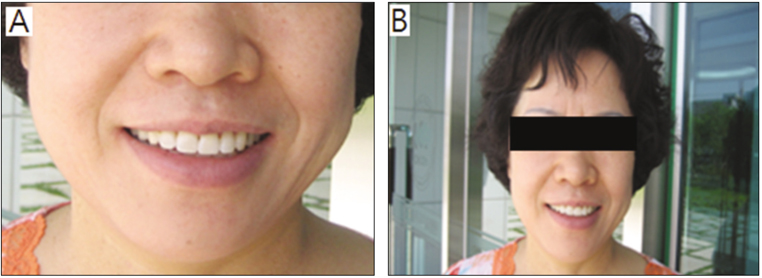J Korean Acad Prosthodont.
2012 Oct;50(4):249-257. 10.4047/jkap.2012.50.4.249.
A study on the smile according to age and esthetic evaluation by the degree of dental knowledge
- Affiliations
-
- 1Department of Prosthodontics, School of Dentistry, Chonnam National University, Gwangju, Korea. psw320@chonnam.ac.kr
- KMID: 2195466
- DOI: http://doi.org/10.4047/jkap.2012.50.4.249
Abstract
- PURPOSE
This study was designed to help to provide the criteria of the esthetic smile in oromaxillary region on twenties, fifties and sixties.
MATERIALS AND METHODS
The facial straight photographs of 33 adults (male 15, female 18, mean age 27.2 years old) and 20 seniors (male 7, female 13, mean age 55.6 years old) in resting and smile position were taken. The measurements and proportion of lip-teeth relation during smile were statistically analyzed, and survey of freshmen and seniors who belong to School of Dentistry, Chonnam National University were taken to select the best esthetic smile among the photographs.
RESULTS
In the relationship between the upper lip and the teeth, average smile was the most frequent, and mean of smile line ratio was 1.090 in young group and 0.90 in old group. The correlation between the buccal corridor ratio and exposed teeth count was inversed. At smile, most frequently exposed tooth was the second premolar (63.64%) in young gourp and the first premolar (35.00%) in old group. The correlation between the upper lip change ratio and exposed clinical crown length of maxillary central incisor was inverse, but there was no correlation between the lower lip change ratio and exposed clinical crown length of maxillarycentral incisor.
CONCLUSION
In the result of survey, the students selected the case exposed to the first premolar as the most esthetic smile. The most esthetic smile between full facial photograph and the lip only photograph by the freshmen was different, but that by seniors was identical.
Keyword
Figure
Reference
-
1. Kim SH, Suhr CH. A roentgenocephalometric study on the soft tissue of the children in mixed dentition. Korean J Orthod. 1985. 15:229–238.2. Miller CJ. The smile line as a guide to anterior esthetics. Dent Clin North Am. 1989. 33:157–164.3. Frush JP, Fisher RD. How dentogenicsinterprets the personalityfactor. J Prosthet Dent. 1956. 6:441–449.4. Hulsey CM. An esthetic evaluation of lip-teeth relationships present in the smile. Am J Orthod. 1970. 57:132–144.
Article5. Tjan AH, Miller GD, The JG. Some esthetic factors in a smile. J Prosthet Dent. 1984. 51:24–28.
Article6. Yoon ME, Jin TH, Dong JK. A study on the smile in Korean youth. J Korean Acad Prosthodont. 1992. 30:259–271.7. Kim HS, Jin TH, Dong JK. A study on the relation between lip and teeth at smile in old aged Korean. J Korean Acad Prosthodont. 1993. 31:533–541.8. Shillingburg HT, Hobo S, Whitsett LD. Fundamentals of fixed prosthodontics. 1996. 2nd ed. Chicago: Quintessence Int.9. Lombardi RE. Factors mediating against excellence in dental esthetics. J Prosthet Dent. 1977. 38:243–248.
Article10. Renner RP. An introduction to dental anatomy and esthetics. 1985. Chicago: Quintessence Int;241–273.
- Full Text Links
- Actions
-
Cited
- CITED
-
- Close
- Share
- Similar articles
-
- Esthetic restoration using Digital Smile Design: a case report
- Using 3-dimensional digital smile design in esthetic restoration of anterior teeth: A case report
- Factors affecting smile esthetics in adults with different types of anterior overjet malocclusion
- Use of Digital Smile Design in esthetic restoration in anterior teeth: A case report
- Evaluation of the lip during smile in normal occlusion adults




